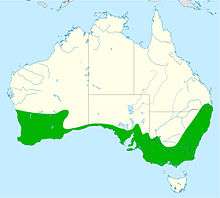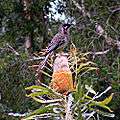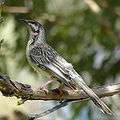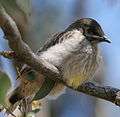Red wattlebird
| Red wattlebird | |
|---|---|
 | |
| Scientific classification | |
| Kingdom: | Animalia |
| Phylum: | Chordata |
| Class: | Aves |
| Order: | Passeriformes |
| Family: | Meliphagidae |
| Genus: | Anthochaera |
| Species: | A. carunculata |
| Binomial name | |
| Anthochaera carunculata (Shaw, 1790) | |
 | |
| Distribution map of the red wattlebird | |
The red wattlebird (Anthochaera carunculata) is a honeyeater native to southern Australia. It is a large, around 35 cm (14 in) in length, grey-brown honeyeater with red eyes, distinctive pinkish-red wattles either side of the neck and white streaks on the chest and belly, which reveals a bright yellow patch towards the tail. The sexes are similar in plumage. Juveniles have less prominent wattles and browner eyes. The species is found in southeast Queensland, New South Wales, Victoria, South Australia and southwest Western Australia in open forest, woodland, and near human habitation.
Taxonomy
The red wattlebird was first described as the wattled bee-eater by Irish surgeon and naturalist John White in his Journal of a Voyage to New South Wales which was published in 1790.[1] He wrote that it was the "size of a missel thrush, but much larger in proportion".[2] The taxonomic descriptions in White's book are believed to have been written by the English naturalist George Shaw.[3][4] The specific epithet, carunculata, was introduced later in the same year by John Latham.[5][6] It is derived from the Latin caruncula for a small piece of flesh, a diminutive of caro, carnis.[7] Both Shaw and Latham assigned the red wattlebird to the genus Merops. The species was moved to Anthochaera in 1827 by the naturalists Nicholas Aylward Vigors and Thomas Horsfield.[8][9]
Common names include gillbird,[10] gilly warbler, barkingbird, muttonbird, butcherbird, what's o clock and chock.[11] Unlike many species in southwestern Australia, the red wattlebird was given names by the local indigenous people that were onomatopoeic. Names recorded include wodjalok, durdal, doongorok, and djoongong (this last name is also applied to the western wattlebird).[12]
There are three recognised subspecies,[13] though there is a zone of intermediate birds across western Victoria and eastern South Australia, bordered by western Port Phillip Bay to the east, Mount Lofty Ranges to the West and Little and Big Desert parks to the north.[14]
- A. c. carunculata (Shaw, 1790) – found in southeast Australia, namely Victoria, eastern New South Wales and southeastern Queensland.[14]
- A. c. clelandi (Mathews, 1923) – Kangaroo Island (off south Australia). Of a similar size to the nominate subspecies, it tends to have darker plumage, a longer bill and shorter tarsus.[15]
- A. c. woodwardi Mathews, 1912 – southwest and south-central Australia west of the Mount Lofty Ranges. This subspecies is a little smaller than the nominate subspecies, with more prominent yellow plumage on the belly.[14]
Analysis of DNA showed that the closest relative of the red wattlebird is the yellow wattlebird of Tasmania, the pair splitting from the ancestor of the regent honeyeater—their next closest relative.[16] Honeyeaters are related to the Pardalotidae (pardalotes), Acanthizidae (Australian warblers, scrubwrens, thornbills, etc.), and Maluridae (Australian fairy-wrens) in a large Meliphagoidea superfamily.[17]
Description
The sexes of the red wattlebird are similar in size and plumage, the length of the adult male ranging from 33 to 37 cm (13 to 14 1⁄2 in) and adult female 34 to 37 cm (13 1⁄2 to 14 1⁄2 in).[11] The crown, forehead and upper lores are dark brown, streaked with pale brown on the forecrown and white on the hindcrown. The nape is slightly paler brown.with white streaks. A whitish triangular marking covers the lower lores and anterior ear coverts, bordered below by a dark brown stripe from the lower mandible down to the wattle and around to behind the eye. The throat is dark brown streaked with white.[18] The iris of the eye is orange-red to crimson,[19] and there are distinctive pinkish-red wattles either side of the neck dangling from the lower rear corner of ear-coverts as well as a sliver of pink bare skin at the lower border of the white facial marking.[11] The chest and belly are streaked white, and there is a bright yellow patch towards the tail.[20] The downward-curving bill is black and the strong legs and feet are pink or pinkish-brown.[21] Juveniles are generally less flamboyant, with less prominent wattles and browner eyes.[20] In common with other honeyeaters, the red wattlebird has a long specialized tongue to extract nectar from flowers.[22] The tongue can extend well beyond the tip of the bill and is divided at the end to form a brush-like structure with over a hundred bristles that soak up nectar by capillary action.[23]
The red wattlebird is hard to confuse with any other species, though in poor visibility might be mistaken for the spiny-cheeked honeyeater, or little or western wattlebirds.[11]
Call
They are noisy birds that produce a range of raucous calls. Pairs of birds appear to duet, particularly at food sources, with the male producing a loud cackle and the female a whistling call.[20]
Distribution and habitat
The red wattlebird is found in southeast Queensland, where it occurs south of Noosa and Cooloola, becoming more common south of Brisbane and Toowoomba. Further south into New South Wales it is found most places east of (and including) the Great Dividing Range and stretching west to the southern North-West Plain, Central Western Slopes and eastern Riverina, and is an occasional visitor to points along the Murray River valley. It is found across Victoria, though is uncommon in the northwest of the state. In South Australia, Devonborough Downs Station, Manunda, Wilpena Pound and Nullarbor Station mark the northern limits of its range. There are scattered records from the Nullarbor Plain, but is common in Western Australia west of 125 °E and south of 29 °S.[24] The yellow wattlebird replaces it in Tasmania.
The red wattlebird appears to be sedentary (present year-round) in much of its range, though its movements are poorly known. It appears to be partly migratory in Western Australia and the north coast of New South Wales. In southeastern New South Wales and the Australian Capital Territory, it appears to move to lower altitudes for winter. Overall, little pattern is discernible in the species' movements, though it does appear that red wattlebirds move to feed on populations of flowering banksias and eucalypts, such as winter-flowering banksias in Perth over the cooler months.[25]
It has become more common in some localities, such as the Sunraysia district in the 1960s and Nambucca Heads and Lefevre Peninsula in the 1980s.[24] Numbers breeding have increased in Sydney and Adelaide.[26]
The red wattlebird is a rare vagrant to New Zealand, with confirmed records at Matakana in 1865 and Rohutu, Taranaki in 1885, and a third unconfirmed from Motupiko in 1938.[24]
Open sclerophyll forest and woodland, generally dominated by eucalypts, is the most common habitat of the species. It is more common in forests with ample shrubby or grassy understory. It is less commonly encountered in scrub, heath, or margins of wet sclerophyll forest. It is rarely found in mature pine plantations. Within areas of human habitation, it is abundant in areas such as parks and reserves, gardens and golf courses, as well as orchards and vineyards.[24]
Behaviour
Feeding
Foraging takes place mostly in trees, in particular climbing along branches (rather than the trunk) and at flower heads, probing flowers with their bills.[27] One study in Bondi State Forest revealed red wattlebirds foraged at a height of 5.9 ± 5.8 m. They seldom forage on the ground, though do so to feed on shrubs such as kangaroo paws (Anigozanthos species) or seize invertebrates in grass. Red wattlebirds prioritise visiting flowers that produce a lot of nectar, such as eucalypts, banksias, grasstrees (Xanthorrhoea) and emu bushes (Eremophila).[27] In addition to nectar, it takes insects and other small creatures, usually by hawking, and also berries and other fruit.[20]
One field study found that red wattlebirds foraged for longer periods when nectar concentrations in flowers were low, and consumed fewer insects at this time. However, this could have been because the temperature was lower and hence insects were less active.
Fieldwork at several sites around central New South Wales showed that red wattlebirds foraged more often on the foliage of the grey gum (Eucalyptus punctata) over other trees, though did also show some preference for narrow-leaved ironbark (E. crebra) if grey gum was not present. Red wattlebirds also appeared to oust noisy friarbirds (Philemon corniculatus) if both species were present.[28]
The red wattlebird often forages alongside the New Holland honeyeater (Phylidonyris novaehollandiae), little friarbird (P. citreogularis), western and little wattlebirds, rainbow lorikeet (Trichoglossus moluccanus), purple-crowned lorikeet (Glossopsitta porphyrocephala), satin bowerbird (Ptilonorhynchus violaceus), pied currawong (Strepera graculina) and crimson rosella (Platycercus elegans), though they generally chase other nectar-feeding birds away from a horde of eucalypt flowers.[29]
Breeding
The red wattlebird breeds throughout its range, with nesting taking place between July and December, though occasionally outside these months if conditions are favourable. One or two broods are laid each year.[30]
Birds generally nest as solitary pairs.[31] The nest is a bowl-shaped structure formed from sticks and leaves lined with bark, grass and hair,[30] between 2 and 16 metres (7 and 50 ft) above ground, usually in the forked branches of a tree—generally a eucalypt.[30] The nest is generally centrally located rather than in the periphery of the tree.[32] A study in Eastwood State Forest near Armidale in New South Wales found that red wattlebirds preferred to nest in manna gum (Eucalyptus viminalis) and apple box (E. bridgesiana).[32]
A clutch of two or three, pale brown- and lavender-spotted pinkish eggs are normally laid. They measure 33 mm × 22 mm (1.30 in × 0.87 in) and are a tapered oval in shape.[30] The eggs are normally incubated by both parents, but sometimes just by the female. They hatch after 16–21 days.[20] The chicks are born almost naked with a small amount of grey down on their head and body.[33] They are mostly brooded by the female but sometimes the male will also do so. The nestlings are fed by both parents, and occasionally immature birds will also contribute. Their eyes open at around 7 days.[34] They fledge 15–20 days after hatching and both parents continue to feed them for a further 2–3 weeks.[20]
The nests of red wattlebirds are often parasitized by the pallid cuckoo (Cacomantis pallidus), and less commonly by the Pacific koel (Eudynamys orientalis). Nest predators include the brown goshawk (Accipiter fasciatus), black falcon (Falco subniger), pied currawong, Australian raven (Corvus coronoides), common brushtail possum (Trichosurus vulpecula), domestic cat, and snakes.[18]
Interactions with people
Red wattlebirds are adversely impacted by land and undergrowth clearing, and have vanished from some habitats thus altered.[26] They are regularly killed by cats and dogs, as well as being hit by cars on roads.[26]
In 1924 in northern Victoria, the red wattlebird was described as very wary, on account of being highly regarded (and shot) for its meat.[35] Indeed, it was shot widely for food or sport,[10] or because it was held to be a pest of vineyards or orchards.[26] On occasion, red wattlebirds have raided vineyards and orchards for grapes, stone fruit, figs, olives, loquat, apples, pears and berries, which they puncture and extract the juice or flesh from.[36]
Parasites
Isospora anthochaerae is an Apicomplexan parasite that has been isolated from the red wattlebird in Western Australia.[37]
Gallery

 Feeding on Banksia sp. flower, Perth
Feeding on Banksia sp. flower, Perth
- Top view

 Chick
Chick Feeding
Feeding
 Showing Lemon-Yellow plumage
Showing Lemon-Yellow plumage In a Banksia, Sydney, Australia.
In a Banksia, Sydney, Australia.
References
- 1 2 BirdLife International (2012). "Anthochaera carunculata". IUCN Red List of Threatened Species. Version 2013.2. International Union for Conservation of Nature. Retrieved 26 November 2013.
- ↑ White 1790, p. 144.
- ↑ White 1790, p. 240.
- ↑ Nelson, E.C. (1998). "John White A.M., M.D., F.LS. (c. 1756–1832), Surgeon-General of New South Wales: a new biography of the messenger of the echidna and waratah". Archives of Natural History. 25 (2): 149–211. doi:10.3366/anh.1998.25.2.149.
- ↑ Salomonsen 1967, pp. 446-447.
- ↑ Latham 1790, p. 276.
- ↑ Jobling 2010, p. 92.
- ↑ Vigors & Horsfield 1827, pp. 320-321.
- ↑ Salomonsen 1967, pp. 444-445.
- 1 2 Gilbert, P.A. (1928). "Notes on Honeyeaters". Emu. 23 (2): 109–18. doi:10.1071/MU923109.
- 1 2 3 4 Higgins 2001, p. 463.
- ↑ Abbott, Ian (2009). "Aboriginal names of bird species in south-west Western Australia, with suggestions for their adoption into common usage" (PDF). Conservation Science Western Australia Journal. 7 (2): 213–78 [262].
- ↑ Gill, Frank; Donsker, David (eds.). "Honeyeaters". World Bird List Version 5.4. International Ornithologists' Union. Retrieved 26 December 2015.
- 1 2 3 Higgins 2001, p. 478.
- ↑ Higgins 2001, p. 479.
- ↑ Driskell, Amy C.; Christidis, Les (2004). "Phylogeny and Evolution of the Australo-Papuan Honeyeaters (Passeriformes, Meliphagidae)". Molecular Phylogenetics and Evolution. 31 (3): 943–60. doi:10.1016/j.ympev.2003.10.017. PMID 15120392.
- ↑ Barker, F.Keith; Cibois, Alice; Schikler, Peter; Feinstein, Julie; Cracraft, Joel (2004). "Phylogeny and diversification of the largest avian radiation". Proceedings of the National Academy of Sciences of the United States of America. 101 (30): 11040–45. doi:10.1073/pnas.0401892101. PMC 503738
 . PMID 15263073.
. PMID 15263073. - 1 2 Higgins 2001, p. 476.
- ↑ Higgins 2001, p. 477.
- 1 2 3 4 5 6 Higgins, P.; Christidis, L.; Ford, H. (2016). "Red Wattlebird (Anthochaera carunculata)". In del Hoyo, J.; Elliott, A.; Sargatal, J.; Christie, D.A.; de Juana, E. Handbook of the Birds of the World Alive. Lynx Edicions. Retrieved 2 January 2016.(subscription required)
- ↑ Higgins 2001, pp. 463, 469.
- ↑ Ford 2001, p. 457.
- ↑ Higgins 2001, p. 469.
- 1 2 3 4 Higgins 2001, p. 464.
- ↑ Higgins 2001, p. 466.
- 1 2 3 4 Higgins 2001, p. 465.
- 1 2 Higgins 2001, p. 468.
- ↑ Saunders, Anthony S. J.; Burgin, Shelley (2001). "Selective foliage foraging by Red Wattlebirds, Anthochaera carunculata, and Noisy Friarbirds, Philemon corniculatus". Emu. 101 (2): 163–66. doi:10.1071/MU00007.
- ↑ Higgins 2001, p. 467.
- 1 2 3 4 Beruldsen, Gordon (2003). Australian Birds: Their Nests and Eggs. Kenmore Hills, Queensland: self. pp. 319–20. ISBN 0-646-42798-9.
- ↑ Higgins 2001, p. 474.
- 1 2 Ford, Hugh A. (1999). "Nest Site Selection and Breeding Success in Large Australian Honeyeaters: Are There Benefits from Being Different?". Emu. 99 (2): 91–99. doi:10.1071/MU99012.
- ↑ Higgins 2001, pp. 475-476.
- ↑ Higgins 2001, p. 475.
- ↑ Leach, Hugh A.C. (1928). "The birds of Central Northern Victoria". Emu. 28 (2): 83–99. doi:10.1071/MU928083.
- ↑ Department of Primary Industries (Agriculture). "Fact Sheets for Breeders" (PDF). Managing bird damage to fruit and other horticultural crops. New South Wales Government. p. 167. Retrieved 12 July 2016.
- ↑ Yang, Rongchang; Brice, Belinda; Ryan, Una (2014). "Isospora anthochaerae n. sp. (Apicomplexa: Eimeriidae) from a Red wattlebird (Anthochaera carunculata) (Passeriformes: Meliphagidae) in Western Australia" (PDF). Experimental Parasitology. 140: 1–7. doi:10.1016/j.exppara.2014.02.011.
Cited texts
- Ford, H.A. (2001). "Family Meliphagidae honeyeaters and Australian chats" (PDF). In Higgins, Peter J.; Peter, Jeffrey M.; Steele, W.K. Handbook of Australian, New Zealand and Antarctic Birds. Volume 5: Tyrant-flycatchers to Chats. Melbourne: Oxford University Press. pp. 457–461. ISBN 0-19-553258-9.
- Jobling, James A. (2010). The Helm Dictionary of Scientific Bird Names. London: Christopher Helm. ISBN 978-1-4081-2501-4.
- Higgins, Peter J.; Peter, Jeffrey M.; Steele, W. K., eds. (2001). "Anthochaera carunculata Red Wattlebird" (PDF). Handbook of Australian, New Zealand and Antarctic Birds. Volume 5: Tyrant-flycatchers to Chats. Melbourne: Oxford University Press. pp. 463–481. ISBN 0-19-553258-9.
- Latham, John (1790). Index Ornithologicus, Sive Systema Ornithologiae: Complectens Avium Divisionem In Classes, Ordines, Genera, Species, Ipsarumque Varietates (Volume 1) (in Latin). London: Leigh & Sotheby.
- Salomonsen, F. (1967). "Family Maliphagidae, Honeyeaters". In Paynter, R.A. Jnr. Check-list of birds of the world (Volume 12). Cambridge, Mass.: Museum of Comparative Zoology. pp. 338–450.
- Vigors, N.A.; Horsfield, T. (1827). "A description of the Australian birds in the collection of the Linnean Society; with an attempt at arranging them according to their natural affinities (Part 1)". Transactions of the Linnean Society of London. 15 (1): 170–331. The title page of the issue has the year 1826.
- White, John (1790). Journal of a Voyage to New South Wales with Sixty-five Plates of Non-descript Animals, Birds, Lizards, Serpents, Curious Cones of Trees and Other Natural Productions. London: J. Debrett.
Further reading
- Hopper, S.D.; Burbidge, A.H. (1978). "Assortative pollination by Red Wattlebirds in a hybrid population of Anigozanthos Labill". Australian Journal of Botany. 26 (3): 335–350. doi:10.1071/BT9780335.
- Paton, D.C.; Ford, H.A. (1977). "Pollination by birds of native plants in South Australia". Emu. 77 (2): 73–85. doi:10.1071/MU9770073.
- Paton, D.C.; Collins, B.G. (1989). "Bills and tongues of nectar-feeding birds: A review of morphology, function and performance, with intercontinental comparisons". Australian Journal of Ecology. 14 (4): 473–506. doi:10.1111/j.1442-9993.1989.tb01457.x.
External links
| Wikimedia Commons has media related to Anthochaera carunculata. |
| Wikispecies has information related to: Anthochaera carunculata |
- Holotype of the red wattlebird Anthochaera carunculata in the collection of the Museum of New Zealand Te Papa Tongarewa
- Internet Bird Collection: videos, photos and sound recordings of the red wattlebird
- Xeno-canto: Sound recordings of the red wattlebird
